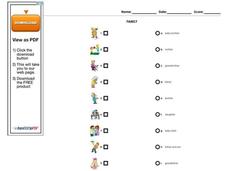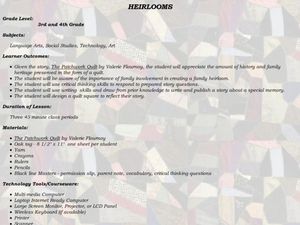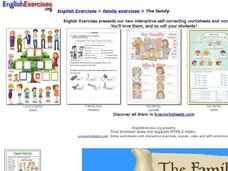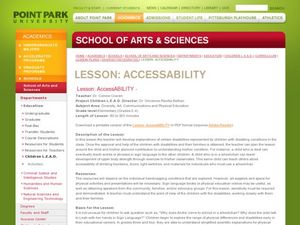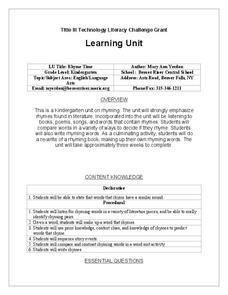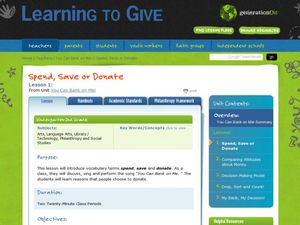Curated OER
Family
In this ESL family worksheet, students will focus on members of the family. Students will complete 10 matching questions, by looking at the pictures in one column and matching them with the correct terminology and vocabulary from the...
Curated OER
Family- Who Am I?
In this ESL vocabulary building activity, students examine 7 pictures of family members and read the clue. Students select the correct answer from 4 choices. Example: My auntie's son is my ...(cousin).
Curated OER
Unique Family Traditions
Second graders examine unique family traditions. In this family tradition lesson, 2nd graders listen to a book about immigration. They interview a family member to determine where their ancestors came from and choose an article to share...
Curated OER
Heirlooms
Learners design a quilt square to reflect their special memory. In this family heirlooms lesson, students read The Patchwork Quilt and discuss the importance of family involvement in creating a family heirloom. Learners write and publish...
Curated OER
English Exercises: The Family
In this family vocabulary worksheet, students complete a 50 question online interactive exercise. Students study an illustrated family tree and identify family members. There is an audio component to this worksheet.
Curated OER
Family Quilts Keep Us Warm
Students discuss and describe the differences and similarities in families. After reciting finger plays about families, they draw pictures of their own families. Next, they incorporate their family pictures into a paper quilt.
Curated OER
Teacher Grants: Teachnet Ready-Set-Tech
Students are introduced to each sound made by the four instrument families. Individually, they create their own short song using at least one of the sounds. They use the internet to research the history of the four instrument families...
Curated OER
Immigration to the United States
Students work together as a class to create a videotape examining their different family histories. They interview their families about their experiences immigrating to America. They draw illustrations of their family to be included on...
Curated OER
Online Esl Quizzes- Apostrophes - 1
In this apostrophes worksheet, students choose the sentence that shows the correct use of an apostrophe in possessives in 5 examples. They complete the quiz online.
Curated OER
Family Life
Students investigate the lives of families in two different centuries. They compare the 1600's to the 1800's. Students write an essay about the differences and how they developed in history. Special attention is paid to the external...
Curated OER
AccessABILITY
Young scholars examine certain disabilities represented by children with disabling conditions in the class. In this generic differences and disabilities instructional activity, students design an art project depicting one word or phrase...
Curated OER
Classifying Functions
Eleventh graders sort different types of functions including rational, periodic, exponential, polynomial, quadratic, logarithmic and linear using "function cards." The functions are displayed in multiple representations including...
Curated OER
Writing About a Christmas Day Celebration
Students write about a Christmas Day Celebration they have experienced. In this personal narrative lesson, students use descriptive words to tell a story about their own family's Christmas. Students organize plot and develop the story as...
Curated OER
Family Communication Style
Eighth graders explore the different ways that families communicate with each other. After a lecture/demo, 8th graders generate a list of relationships that might benefit from practice in the art of conversation and communication.
Curated OER
History of the American Family
Students discover the history of the American family and the affects of immigration. In addition, they examine the contributions of minority families to American culture. In groups, students explore the pros and cons of dual-income...
Curated OER
My Health Plan
Second graders discuss various ways they can help out at home. After exploring the various members of their families and how they are comprised, 2nd graders identify ways they can get along with their family members. They create an...
Curated OER
Rhyme Time
Students listen to a variety of stories and identify rhyming words. They sequence events in the story and generate rhymes of their own. They sort words by rhyming families and write rhymes of their own.
Curated OER
Trade (Hawai'i)
Students gain further understanding of the diversities of trade and the cultural impact of the trade items. Students evaluate and analyze trade items and use this knowledge to make sound trade decisions. Students describe and analyze the...
Curated OER
Periodic Table & Its Trends-Day 1
Students are introduced to the periodic table. They find the common trends among the electron configurations and the names of certain groups of the table. Students explore the atomic mass, atomic number, mass number, mass and charge...
Curated OER
The Icky Sticky Igloo
Learners focus on the correspondence i=/i/. They explore the sound and spelling of /i/ and discover vowels are used to spell all words in our vocabulary, so therefore it is important for students to understand the phoneme and grapheme of...
Curated OER
Streamlining Your Writing
In this writing skills worksheet, students improve their writing by completing the three exercises. Students improve wordy phrases, add possessive nouns, and then write a description of a dramatic weather event.
Curated OER
D says DUH! Duh?
Pupils identify the letter D, both upper and lower case and recognize and identify the letter d in various words and illustrations. They identify how the mouth moves with the letter D through various word pronunciations. Finally,...
Curated OER
You Can Bank on Me!
Students identify reasons people choose to donate. In this donating lesson plan, students contrast the words spend, save, and donate. Students learn a song about donating, brainstorm reasons to give, and make sound choices with their money.
Curated OER
Lots of Labels
Students examine labels in the classroom to connect the written word with a message. They discover photographs of local buildings and their purpose. They also practice the classroom rules based on the labels.


